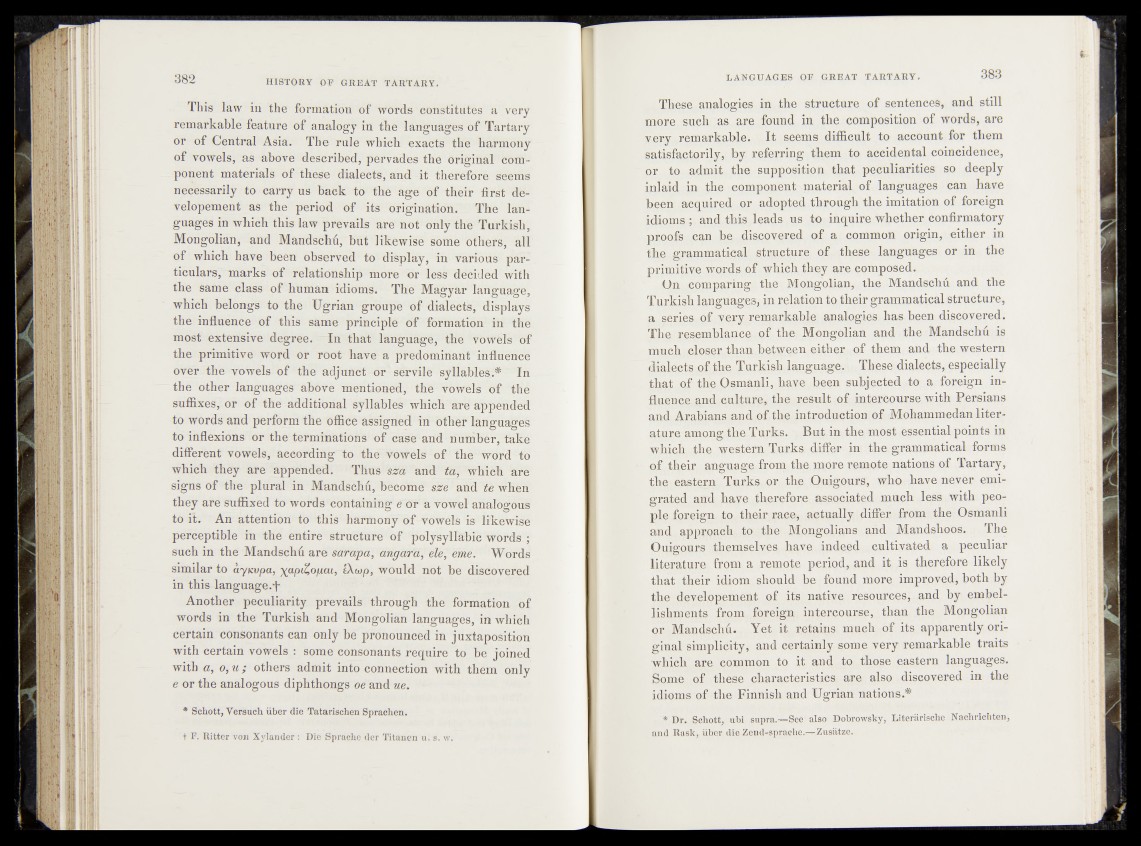
This law in the formation of words-constitutes a very
remarkable feature’of analogy in the languages of Tartary
or of Central Asia. The rule which exacts the harmony
of vowels, as above described, pervades thé Original cénÿ-
ponent materials of these dialects, and-it therefore seems
necessarily to carry us back to the age of their first Itr-
velopement as the period of its origination. The HÉî
guages in which this law prevails are not only the Turkish,
Mongolian, and Mandschü, but likewise some 'others, all
of which have been observed tof display |%h various particulars,'
marks of relationship more or Ie§S- decided with
the same class of human idioms. The Magyar language'”
which belongs to thé TIgrian groupe of dialects^dis^läys
the influence of this same principle of formationf in the
most extensive degree. In that language, the âv6wéls of
the primitive word or root have a prédominant infî#ëfflÉe
over the vowels of the adjunct «or ' sèrvilé'7 Sylläblhlf.# In
the other languages^ above mentioned, Hh^Ybwels of the
suffixes, or of the additional syllables which are append^!
to words and perform the officé assigned irifother langüa^gés
to inflexions or the terminations of ease and i number, ’take
different vowels, according to 4he vowels of the word to
which they are appended. Thus lsM and ta, which are
signs of the plural in Mattdschu, bécoltaè: slfe5 and Whëh
they are suffixed to words containing éfur a ;fbwel àhâlô'^dus
to il. An attention to this harmony of-vowels Wdfli'ewis^
perceptible in the entire structure of polysyllabic words ;
such in the Mandsché arë sarapa, angaria, ëlè^ ’ème. Words
similar to ayicvpa, \apiZ,opm, IXtop, would not be discovered
in this language .*f*
Another peculiarity prevails through the formation of
words in the Turkish and Mongolian languages, in which
certain consonants can only be pronounced in juxtaposition
with certain vowels : some consonants require to be joined
with a, o, u ; ' others admit into connection with them only
e or the analogous diphthongs oe and ue.
* Schott, Versuch über die Tatarischen Sprachen.
t F. Ritter von Xylander : Die Sprache der Titanen u. s. w.
These,,. analogies in the structure of sentences, and still
more such,as. are found in the composition of words, are
^^y^^marj^able-. I tti seems, difficult to account for them
SatisfaptcpiJi^ by, referring them to accidental coincidence,
o rvJp admit the supposition that peculiarities so deeply
inlaid in the icq^ponenj^paaterial of languages can have
or adopted through the imitation of foreign
idioms and this leads,,us to inquire Whether confirmatory
rvijnnffl can be ^is^ver,o,dr, ^ n common origin, either in
the grammatimL^ j^ucture^ ,ofo these languages or in the
primitiveÄO^sfo;| which they are composed.
/On. cnjuparing the. Mongolian, thp* Mandschü and the
Turkish languas^, in relation to their grammatical;structure,
n.vSeries of very remarkahbi analogies.has been discovered.
The resembla^aceyol the Mongolian and the Mandschu.is
much closer than bptjyeenether ofthena. and the westerh
dialeets^pf the Turkish.language.,', These dialects, especially
tjiat qf the Osmanli, have, {been subjected to.a foreign in-
fljipnae^and .culture, th%fpsult of tintercourse with Persians
and Arabians and of the introduction of Mohammedan literature
among the Turks. But in,the inpst essential points in
which th.e .wes^ep Turks differ-^jglthe grammatical;forms
pf{ tfieir anguag^from the more remote nations of Tartary,
the eastern Tqrks^or the Ouigours, who have never emigrated
and have therefore,,associated much less .with people
foreign to their race, actually; differ from, the Osmanli
and approach to the Mongolians and Mandshoos. • The
Ouigours themselves havq„indeed cultivated a , peculiar
literature from a remote period, and it ,is therefore likely
that their idiom should bp; found more improved, both by
the devejqpement of its native,-resources, and by embellishments
from foreign intercourse, than the Mongolian
or Mandschü. Yet it retains much of its apparently original
simplicity, and certainly some very remarkable traits
which are common to, it and to those eastern languages.
Some of these characteristics are also discovered in the
idioms of the Finnish and Ugrian nations.*
* Dr. Schott, ubi supra.—See also Dobrowsky, Literarische Nachrichten,
and Rusk, über die Zend-spraclie.—Zusätze.